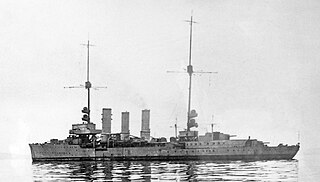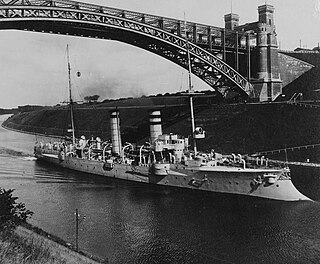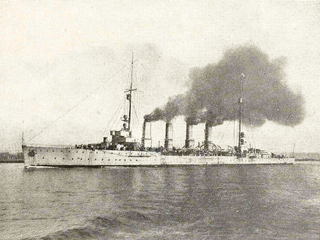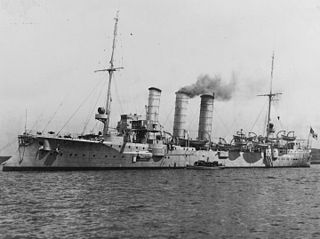
SMS Moltke was the lead ship of the Moltke-class battlecruisers of the German Imperial Navy, named after the 19th-century German Field Marshal Helmuth von Moltke. Commissioned on 30 September 1911, the ship was the second battlecruiser of the Imperial Navy. Moltke, along with her sister ship Goeben, was an enlarged version of the previous German battlecruiser design, Von der Tann, with increased armor protection and two more main guns in an additional turret. Compared to her British rivals—the Indefatigable class—Moltke and her sister Goeben were significantly larger and better armored.

SMS Pommern was one of five Deutschland-class pre-dreadnought battleships built for the Kaiserliche Marine between 1904 and 1906. Named after the Prussian province of Pomerania, she was built at the AG Vulcan yard at Stettin, Germany, where she was laid down on 22 March 1904 and launched on 2 December 1905. She was commissioned into the navy on 6 August 1907. The ship was armed with a battery of four 28 cm (11 in) guns and had a top speed of 18 knots. The ships of her class were already outdated by the time they entered the service, being inferior in size, armor, firepower, and speed to the revolutionary new battleship HMS Dreadnought.

SMS Ariadne was the fifth member of the ten-ship Gazelle class of light cruisers that were built for the German Kaiserliche Marine in the late 1890s and early 1900s. The Gazelle class was the culmination of earlier unprotected cruiser and aviso designs, combining the best aspects of both types in what became the progenitor of all future light cruisers of the Imperial fleet. Built to be able to serve with the main German fleet and as a colonial cruiser, she was armed with a battery of ten 10.5 cm (4.1 in) guns and a top speed of 21.5 knots.

SMS Mainz was a Kolberg-class light cruiser of the German Kaiserliche Marine during the First World War. She had three sister ships, SMS Kolberg, Cöln, and Augsburg. She was built by the AG Vulcan shipyard in Stettin; her hull was laid down in 1908 and she was launched in January 1909. She was commissioned into the High Seas Fleet in October 1909. She was armed with a main battery of twelve 10.5 cm SK L/45 guns and had a top speed of 25.5 kn.

SMS Cöln was a light cruiser in the German Kaiserliche Marine, the second to bear this name, after her predecessor SMS Cöln had been lost in the Battle of Heligoland Bight. Cöln, first of her class, was launched on 5 October 1916 at Blohm & Voss in Hamburg and completed over a year later in January 1918. She and her sister Dresden were the last two light cruisers built by the Kaiserliche Marine; eight of her sisters were scrapped before they could be completed. The ships were an incremental improvement over the preceding Königsberg-class cruisers.

SMS Frauenlob was the eighth member of the ten-ship Gazelle class of light cruisers that were built for the German Kaiserliche Marine in the late 1890s and early 1900s. The Gazelle class was the culmination of earlier unprotected cruiser and aviso designs, combining the best aspects of both types in what became the progenitor of all future light cruisers of the Imperial fleet. Built to be able to serve with the main German fleet and as a colonial cruiser, she was armed with a battery of ten 10.5 cm (4.1 in) guns and a top speed of 21.5 knots. Frauenlob was a modified version of the basic Gazelle design, with improved armor and additional coal storage for a longer cruising range.

SMS Stralsund was a Magdeburg-class light cruiser of the German Kaiserliche Marine. Her class included three other ships: Magdeburg, Breslau, and Strassburg. She was built at the AG Weser shipyard in Bremen from 1910 to December 1912, when she was commissioned into the High Seas Fleet. The ship was armed with a main battery of twelve 10.5 cm SK L/45 guns and had a top speed of 27.5 knots.

SMS Strassburg was a light cruiser of the Magdeburg class in the German Kaiserliche Marine. Her class included three other ships: Magdeburg, Breslau, and Stralsund. Strassburg was built at the Kaiserliche Werft shipyard in Wilhelmshaven from 1910 to October 1912, when she was commissioned into the High Seas Fleet. The ship was armed with a main battery of twelve 10.5 cm (4.1 in) SK L/45 guns and had a top speed of 27.5 knots.

SMS Deutschland was the first of five Deutschland-class pre-dreadnought battleships built for the German Kaiserliche Marine. The ship was armed with a main battery of four 28 cm (11 in) guns in two twin turrets. She was built at the Germaniawerft shipyard in Kiel, where she was laid down in June 1903 and launched in November 1904. She was commissioned on 3 August 1906, a few months ahead of HMS Dreadnought. The latter, armed with ten large-caliber guns, was the first of a revolutionary new standard of "all-big-gun" battleships that rendered Deutschland and the rest of her class obsolete.

SMS Königsberg was the lead ship of the Königsberg class of light cruisers, built for the German Kaiserliche Marine during World War I. She took the name of the earlier Königsberg, which had been destroyed during the Battle of Rufiji Delta in 1915. The new ship was laid down in 1914 at the AG Weser shipyard, launched in December 1915, and commissioned into the High Seas Fleet in August 1916. Armed with eight 15 cm SK L/45 guns, the ship had a top speed of 27.5 kn.

SMS Kolberg was a light cruiser of the German Kaiserliche Marine during the First World War, the lead ship of her class. She had three sister ships, SMS Mainz, Cöln, and Augsburg. She was built by the Schichau-Werke; her hull was laid down in early 1908 and she was launched later that year, in November. She was commissioned into the High Seas Fleet in June 1910. She was armed with a main battery of twelve 10.5 cm SK L/45 guns and had a top speed of 25.5 kn.

The Kolberg class was a group of four light cruisers built for the German Imperial Navy and used during the First World War. The class comprised four vessels: SMS Kolberg, the lead ship, Mainz, Cöln, and Augsburg. The ships were built between 1908 and 1910, and two, Kolberg and Augsburg, were modernized in 1916–1917. The ships were armed with a main battery of twelve 10.5 cm SK L/45 guns and had a design speed of 25.5 knots. The first three ships were assigned to the reconnaissance forces of the High Seas Fleet; Augsburg was instead used as a torpedo and gunnery training ship.

SMS Danzig was a light cruiser of the Imperial German Navy. Named for the city of Danzig, she was the seventh and last ship of the Bremen class. She was begun by the Imperial Dockyard in her namesake city in 1904, launched on 23 September 1905 and commissioned on 1 December 1907. Armed with a main battery of ten 10.5 cm (4.1 in) guns and two 45 cm (18 in) torpedo tubes, Danzig was capable of a top speed of 22 knots.

SMS München was the fifth of seven Bremen-class cruisers of the Imperial German Navy, named after the city of Munich. She was built by AG Weser in Bremen, starting in 1903, launched in April 1904, and commissioned in January 1905. Armed with a main battery of ten 10.5 cm (4.1 in) guns and two 45 cm (18 in) torpedo tubes, München was capable of a top speed of 22.5 knots.
SMS G194 was a S-138-class large torpedo boat of the Imperial German Navy. She was built by the Germaniawerft shipyard at Kiel between 1910 and 1911, and was launched on 25 May 1911, entering service later that year. She served throughout the First World War, taking part in the Battle of Heligoland Bight on 28 August 1914. She was rammed and sunk by the British light cruiser Cleopatra on 26 March 1916.
SMS V188 was a S-138-class large torpedo boat of the Imperial German Navy. She was built by the AG Vulcan shipyard at Stettin between 1910 and 1911 and launched on 8 February 1911.

SMS V190 was a S-138-class large torpedo boat of the Imperial German Navy. She was built by the AG Vulcan shipyard at Stettin between 1910 and 1911, completing on 5 August 1911.
SMS G7 was a V1-class large torpedo boat of the Imperial German Navy. She was built by the Germaniawerft shipyard at Kiel between 1911 and 1912, completing on 30 April 1912.
SMS G8 was a V1-class large torpedo boat of the Imperial German Navy. She was built by the Germaniawerft shipyard at Kiel between 1911 and 1912, completing on 6 August 1912.
SMS G12 was a V1-class large torpedo boat of the Imperial German Navy. She was built by the Germaniawerft shipyard at Kiel between 1911 and 1912.

















